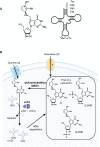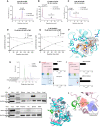Structural basis of Qng1-mediated salvage of the micronutrient queuine from queuosine-5'-monophosphate as the biological substrate
- PMID: 36610787
- PMCID: PMC9881137
- DOI: 10.1093/nar/gkac1231
Structural basis of Qng1-mediated salvage of the micronutrient queuine from queuosine-5'-monophosphate as the biological substrate
Abstract
Eukaryotic life benefits from-and ofttimes critically relies upon-the de novo biosynthesis and supply of vitamins and micronutrients from bacteria. The micronutrient queuosine (Q), derived from diet and/or the gut microbiome, is used as a source of the nucleobase queuine, which once incorporated into the anticodon of tRNA contributes to translational efficiency and accuracy. Here, we report high-resolution, substrate-bound crystal structures of the Sphaerobacter thermophilus queuine salvage protein Qng1 (formerly DUF2419) and of its human ortholog QNG1 (C9orf64), which together with biochemical and genetic evidence demonstrate its function as the hydrolase releasing queuine from queuosine-5'-monophosphate as the biological substrate. We also show that QNG1 is highly expressed in the liver, with implications for Q salvage and recycling. The essential role of this family of hydrolases in supplying queuine in eukaryotes places it at the nexus of numerous (patho)physiological processes associated with queuine deficiency, including altered metabolism, proliferation, differentiation and cancer progression.
© The Author(s) 2023. Published by Oxford University Press on behalf of Nucleic Acids Research.
Figures






References
-
- Kasai H., Ohashi Z., Harada F., Nishimura S., Oppenheimer N.J., Crain P.F., Liehr J.G., von Minden D.L., McCloskey J.A.. Structure of the modified nucleoside Q isolated from Escherichia coli transfer ribonucleic acid. 7-(4,5-cis-dihydroxy-1-cyclopenten-3-ylaminomethyl)-7-deazaguanosine. Biochemistry. 1975; 14:4198–4208. - PubMed
-
- Ohgi T., Kondo T., Goto T.. Total synthesis of optically pure nucleoside Q. Determination of absolute configuration of natural nucleoside Q. J. Am. Chem. Soc. 1979; 101:3629–3633.
-
- Randerath E., Agrawal H.P., Randerath K.. Specific lack of the hypermodified nucleoside, queuosine, in hepatoma mitochondrial aspartate transfer RNA and its possible biological significance. Cancer Res. 1984; 44:1167–1171. - PubMed
Publication types
MeSH terms
Substances
Supplementary concepts
Grants and funding
LinkOut - more resources
Full Text Sources
Molecular Biology Databases
Research Materials

